人教版八年级上册英语第二单元教案
- 格式:doc
- 大小:54.00 KB
- 文档页数:6

Unit 2 What time do you go to school?Section A (1a-2d)一、教学目标:1. 语言知识目标:1) 能掌握以下单词:up, get up, dress, get dressed, brush, tooth (pl. teeth) brush teeth, shower, take a shower, usually, forty, fifty, wow, never, early, job, work, station, radio station, o'clock, funny, exercise能掌握以下句型:①—What time do you usually get up? —I usually get up at six thirty.②—When do you go to work? —I usually go to work at eleven o'clock.③—He has an interesting job. —He works at a radio station.2) 用when和what time引导的特殊疑问句询问时间和时间的表达法;用所学的目标语言对生活和学习活动做计划,学会合理地安排作息时间。
2. 情感态度价值观目标:本部分的话题是“日常作息时间”,学习内容贴近学生的生活,因为学生的作息时间安排是非常有规律的。
通过互相询问或谈论自己或对方的作息时间安排和活动计划,可以培养学生良好的作息习惯和守时习惯。
二、教学重难点1. 教学重点:1) 掌握时间的简单表达方式。
2) 学习询问和谈论时间和制订作息时间表。
2. 教学难点:when和what time引导的特殊疑问句和时间的表达法。
三、教学过程Ⅰ. Warming-up and revision1. Greet the Ss as usual.2. Let’s talk about our daily activities.Ⅱ. Presentation1.出示几幅反映日常事务(如:起床、上学、跑步等)的图画、幻灯片或播放课件,引导学生谈论这些日常事务go to school,get up,run,take a shower,eat breakfast等,学习有关的动词短语。

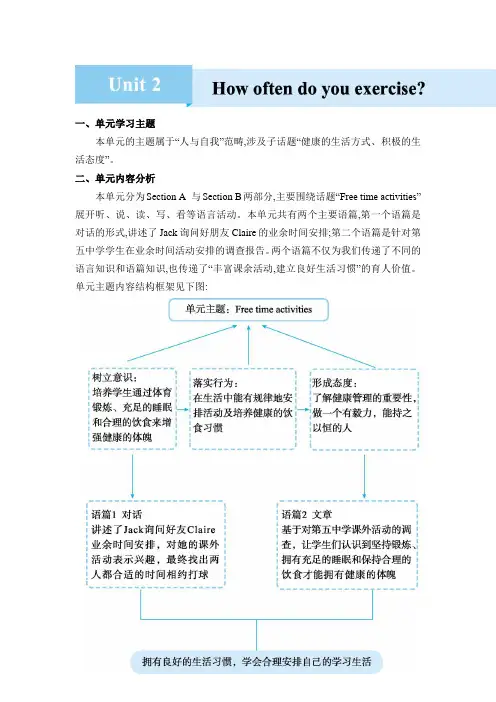
一、单元学习主题
本单元的主题属于“人与自我”范畴,涉及子话题“健康的生活方式、积极的生活态度”。
二、单元内容分析
本单元分为Section A 与Section B两部分,主要围绕话题“Free time activities”展开听、说、读、写、看等语言活动。
本单元共有两个主要语篇,第一个语篇是对话的形式,讲述了Jack询问好朋友Claire的业余时间安排;第二个语篇是针对第五中学学生在业余时间活动安排的调查报告。
两个语篇不仅为我们传递了不同的语言知识和语篇知识,也传递了“丰富课余活动,建立良好生活习惯”的育人价值。
单元主题内容结构框架见下图:。
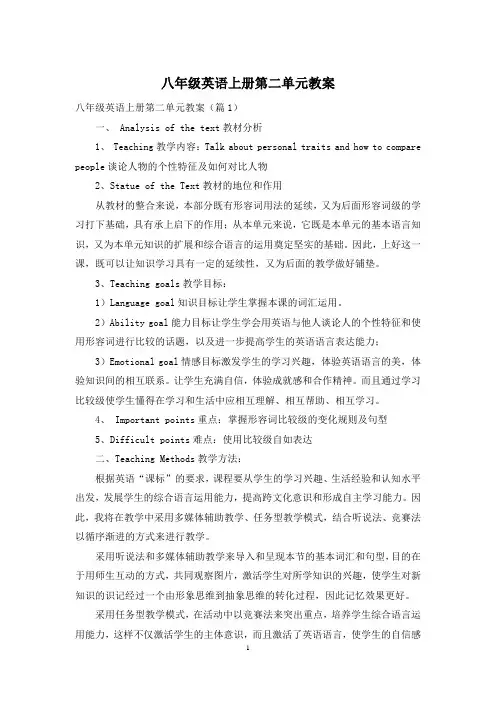
八年级英语上册第二单元教案八年级英语上册第二单元教案(篇1)一、 Analysis of the text教材分析1、 Teaching教学内容:Talk about personal traits and how to compare people谈论人物的个性特征及如何对比人物2、Statue of the Text教材的地位和作用从教材的整合来说,本部分既有形容词用法的延续,又为后面形容词级的学习打下基础,具有承上启下的作用;从本单元来说,它既是本单元的基本语言知识,又为本单元知识的扩展和综合语言的运用奠定坚实的基础。
因此,上好这一课,既可以让知识学习具有一定的延续性,又为后面的教学做好铺垫。
3、Teaching goals教学目标:1)Language goal知识目标让学生掌握本课的词汇运用。
2)Ability goal能力目标让学生学会用英语与他人谈论人的个性特征和使用形容词进行比较的话题,以及进一步提高学生的英语语言表达能力;3)Emotional goal情感目标激发学生的学习兴趣,体验英语语言的美,体验知识间的相互联系。
让学生充满自信,体验成就感和合作精神。
而且通过学习比较级使学生懂得在学习和生活中应相互理解、相互帮助、相互学习。
4、 Important points重点:掌握形容词比较级的变化规则及句型5、Difficult points难点:使用比较级自如表达二、Teaching Methods教学方法:根据英语“课标”的要求,课程要从学生的学习兴趣、生活经验和认知水平出发,发展学生的综合语言运用能力,提高跨文化意识和形成自主学习能力。
因此,我将在教学中采用多媒体辅助教学、任务型教学模式,结合听说法、竞赛法以循序渐进的方式来进行教学。
采用听说法和多媒体辅助教学来导入和呈现本节的基本词汇和句型,目的在于用师生互动的方式,共同观察图片,激活学生对所学知识的兴趣,使学生对新知识的识记经过一个由形象思维到抽象思维的转化过程,因此记忆效果更好。

Unit 2 How often do you exercise?Period 1Learning objectives:●how often exercise skateboard hardly ever once twice time surf internet●熟练运用下列句子what do you usually do on weekends?I usually go to the movies.How often do you go to the movies?Twice a week.Learning important and difficult points:what do you usually do on weekends?I usually go to the movies.How often do you go to the movies?Twice a week.Learning methods:情景教学Learning procedures :Step 1 Leading-in●Greetings:Talt something the students did on教案正文随堂记录summer vacation .Step 2 Pre-taskSB Page 1 , 1a .●Look at the picture (学生识图).●Name each activity .T: What are they doing ?They are shopping /reading /exercising /watching TV /skateboarding .(Help the students to answer )●Write the activities on the line .●Check the answers on the Bb .Correct their own activities .●Practise reading .SB Page 1 , 1c .●Focus on the conversation in the box .●Practise reading .●Pairwork : What do you do on weedends ?●Groupwork :Divide the class into groups of four or five .Make conversations .First S1 to S2:S1:What do you do on weekends ?教案正文随堂记录S2:I .S1:What does she /he do on weekends ?S2:She /He .●Act out their own dialogues .Step 3 While-taskSB Page 1 , 1b .●Look at each picture in 1c.Tell what the person does on weekends .Check the Ss orally.●Mare what they will hear and do .●Read these adverbs and explain.●Play the tape twice .Write the letters on the line.SB Page 2 , 2a & 2b .●read the activities and the answers of “how often”first .●Practise reading .●In 2a we should know the activities you hear .In 2b we should know the answers of how often he does the activities.●Play the tape for a first time .Ss only listen .●Play the tape a second time .Ss do 2a .教案正文随堂记录●Play the tape a third time .Check the answers .●Play the tape .Ss do 2b .●Check the answers .In this part ,we should pay attention to how often引起的特殊疑问句及回答.Step 4 Post-taskSB Page 2 , 2c .●Focus on the conversation .●Practice reading .●Read the activities in the left box .●Fill in the chart .●Pairwork: Make conversations .教案正文随堂记录Period 2Learning objectives:●Highe school result active for as for about●熟练掌握how often do you do ...?I sometimes / often / usually do ...●引导学生谈论别人的业余爱好及做事的频率Learning important and difficult points:学习重点句型How often do you do ...? 及I sometimes/often/usually do ...语法焦点在于How often do you do ...?及Most/Many/Some of ...Learning methods:合作探究Learning procedures :Step 1 Leading-in●Greetings●Drills:T: What do you usually do on weekends ?S1: I usually play soccer .T: How often do you play soccer ?S1: I play soccer twice a week .T: How often does he play soccer ?The other Ss: He plays soccer twice a week .Repeat for three times .Step 2 Pre-taskSB Page 2 ,Grammar Focus .●Review the grammar box .Ss say the questions and answers .●Practise reading .Step 3 While-taskSB Page 3 , Part 3 .教案正文随堂记录●Call attention to the survey .Mare the Ss understand the chart .T: What activity do ninety-five percent of Green High students do every day ?Ss answer .If necessary , give them help .●Review the information in the green box with Ss .●Read the article first by the Ss .●Read it to the class .●Look at the survey and fill in the blanks in the article .●Finish the activity individually .●Check the answers .●Practise reading .Step 4 Post-taskSB Page 3,Part 4 .●T: What can you do to improve your English ?(e.g. read English books, practice reading and speaking ) How often do you●Think of more things you can do to improve your English and write them here . 教案正文随堂记录●Ask several Ss each question .●See: Who is the best English students in the classHomework:Revise the new words .Unit 2 How often do you exercise?Period 3Learning objectives:●junk junk food milk coffee chip cola chocolate drink health how many....●听力和阅读训练●激发学生学习的主动性,乐于谈论生活和饮食习惯方面的问题Learning important and difficult points:●熟练掌握词汇junk junk food milk coffee chip cola chocolate drink health how many....●学习谈论日常动作和行为发生的频率,介绍自己的生活习惯Learning methods:情景交际法Learning procedures :Step 1 Leading in●Greetings & free talk .●Practise reading the article in Page 3.●Check the homework.Step 2 Pre-taskSB Page4 , 1a .●Point out the five phrases .●Ss read after the teacher .●Mare the Ss understand what do they mean .●Call attention to the pictures .Say something about the pictures .●Match the words with the pictures .●Check the answers .●Practice reading .Step 3 While-taskSB Page 4 , 1b .●pay attention to the conversation in the box on the right .教案正文随堂记录●Read it to the class .●Explain : “be good for”means :有益于…,对…有好处.●Pairwork. Choose a new partner .Use the words in Activity 1a to make conversations .●Share the students’conversations.SB Page 4 ,2a&2b .●T : Now you will hear a reporter interview two people ,Katrina & Bill .Read the two names for the Ss. In 2a ,we’ll know who is healthy , Bill or Katrina ?●Read the questions in 2a .●Listen to the tape carefully twice .Circle “yes”, “no”or “I don’t know”in the chart .●Before we check the answers in 2a,we’ll read through the questions in 2b .Pay attention to Katrina’s and Bill’s answers .●Play the tape again .This time ,if we have heard one questions and we have apause .Mare Katrina’s and Bill’s answer.教案正文随堂记录●From the answers in 2b ,we can tell who is healthy Bill or Katrina ?Step 4 Post-taskRole-play .Groupwork .Divide the Ss into groups of three .S1 is interview,S2 is Katrina ,S3 is Bill . S1: How often do you exercise ?S2: I exercise every day .S3: ….With the help of 2b .Homework请同学们用2b里面的问题调查你熟悉的两位同学,写出答案并做比较.Period4⏹Learning objectives:●Practice and using the frequency adverbs : hardly ever, often, sometimes●Describe : what his or her lifestyle is like⏹Learning important and difficult points:●Words :result ,active ,as for , about ,milk, coffee, chocolate, drink, health,exercise●Phrases: help sb to do sth, want sb to do sth ,try to do sth ,every day●Learning methods:Task-based teaching method⏹Learning procedures:The fourth period讲解:1.pretty:adj. 漂亮的,美丽的adv.很,相当when:conj. 当…的时候. 引导时间状语从句1.eating habits饮食习惯2.try to do sth.尽力做/努力做…. Try doing sth.试图做….3.look after 照顾=take care of ,关注,注重4.get good grades:得到好的成绩5.help sb. (to) do sth.6.the same as和…相同7.different (adj.)- (n.)difference good –better-best8.although虽然,尽管,引导让步状语从句,与though同义,但不能与but同时出现在一个复合句中,可与still, yet同用。
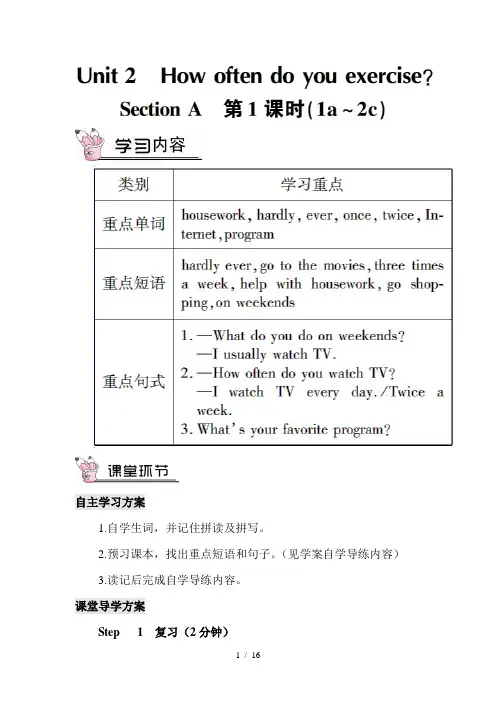
自主学习方案1.自学生词,并记住拼读及拼写。
2.预习课本,找出重点短语和句子。
(见学案自学导练内容)3.读记后完成自学导练内容。
课堂导学方案Step 1 复习(2分钟)1.让一个学生介绍自己周末去哪里旅游了。
2.检查家庭作业。
Step 2 情景导入Teacher: I like Saturday and Sunday. Because I can do many things what I like. I always watch TV. I sometimes help with the housework. I often go shopping. I usually play with my friends. What do you usually do on weekends? Can you tell us what you do on weekends? Please say something to your partner about your weekends.环节说明:以教师自己的周末活动为导线,让学生说出各自周末的活动,引出本课时的学习的同时也锻炼了学生的口语。
Step 3 完成教材1a—1c的任务1.认真观察1a图片中人物的活动,然后用适当的短语来描述人物的活动,完成后小组内互相交流答案。
(3分钟)2.两人一组练习1a图中的对话,请几组学生表演。
3.认真听录音,把1a图片中的字母写在横线上,集体核对答案,完成1b。
(3分钟)4.再听一遍录音,并跟读。
(2分钟)5.仿照1c中的对话,利用1a图片中的人物活动结对练习新对话,并请几组学生表演对话。
(5分钟)6.通过对话练习,学生总结1b中频率副词的用法,教师点拨。
(5分钟)7.小结训练。
(2分钟)( B )(1)I’m very tired. I can _________run.A. alwaysB. hardly everC. everD. sometimes( D )(2)My grandfather _________every day. He looks very healthy.A. exerciseB. do exercisesC. do exerciseD. does exercise环节说明:听说结合,第一时间向学生传达语言目标,通过结对对话练习和小结训练,使语言目标得以强化。

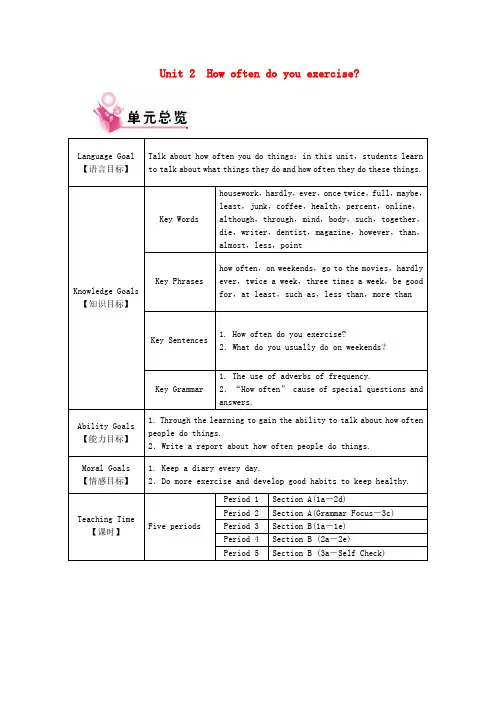
Unit 2 How often do you exercise?Language Goal 【语言目标】Talk about how often you do things:in this unit,students learn to talk about what things they do and how often they do these things.Knowledge Goals 【知识目标】Key Wordshousework,hardly,ever,once twice,full,maybe,least,junk,coffee,health,percent,online,although,through,mind,body,such,together,die,writer,dentist,magazine,however,than,almost,less,pointKey Phraseshow often,on weekends,go to the movies,hardlyever,twice a week,three times a week,be goodfor,at least,such as,less than,more than Key Sentences1. How often do you exercise?2.What do you usually do on weekends?Key Grammar1. The use of adverbs of frequency.2.“How often” cause of special questions andanswers.Ability Goals 【能力目标】1. Through the learning to gain the ability to talk about how often people do things.2.Write a report about how often people do things.Moral Goals 【情感目标】1. Keep a diary every day.2.Do more exercise and develop good habits to keep healthy.Teaching Time 【课时】Five periodsPeriod 1 Section A(1a-2d)Period 2 Section A(Grammar Focus-3c)Period 3 Section B(1a-1e)Period 4 Section B (2a-2e)Period 5 Section B (3a-Self Check)本单元的教学内容围绕“多久做一次运动”这一话题展开。
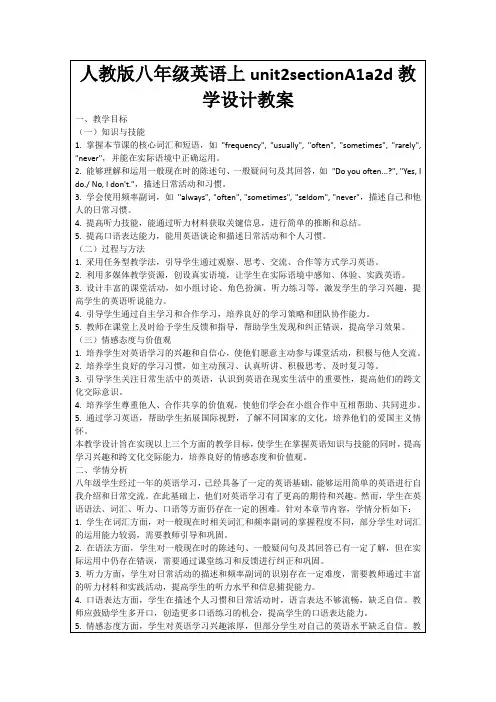
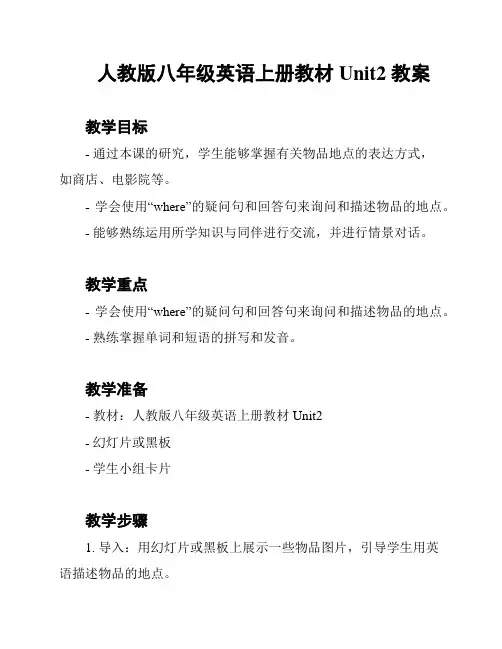
人教版八年级英语上册教材Unit2 教案
教学目标
- 通过本课的研究,学生能够掌握有关物品地点的表达方式,
如商店、电影院等。
- 学会使用“where”的疑问句和回答句来询问和描述物品的地点。
- 能够熟练运用所学知识与同伴进行交流,并进行情景对话。
教学重点
- 学会使用“where”的疑问句和回答句来询问和描述物品的地点。
- 熟练掌握单词和短语的拼写和发音。
教学准备
- 教材:人教版八年级英语上册教材Unit2
- 幻灯片或黑板
- 学生小组卡片
教学步骤
1. 导入:用幻灯片或黑板上展示一些物品图片,引导学生用英
语描述物品的地点。
2. 研究新知:通过教材Unit2的相关内容,教授目标词汇和短语,让学生理解并记忆。
3. 练活动:进行对话练,学生分组,每个小组选择一个物品进行情景对话,询问和回答物品的地点。
4. 拓展活动:让学生运用所学知识,创造自己的对话,交流物品的地点。
5. 归纳总结:让学生回顾所学知识,进行总结归纳。
6. 作业布置:布置课后作业,要求学生练复述本课内容,并使用疑问句和回答句描述物品地点。
教学评价
- 通过学生的课堂表现、练活动和讨论活动来进行评价,检查学生是否能够正确运用所学语言进行物品地点的描述。
- 提供及时的反馈,鼓励学生用英语进行交流。
注意事项
- 确保课堂秩序,引导学生积极参与。
- 注重学生的口语能力培养,鼓励他们进行对话练。
- 提供足够的练机会,让学生熟练掌握所学知识。
以上为人教版八年级英语上册教材Unit2的教案,根据课堂实际情况适当调整教学步骤。

Unit 2 What’s the matter?课前准备:1.学生通过上网,查资料寻找身体各部位英文名称,各种常见疾病表达法课上任务:step 1 Brainstormstep 2 presentationstep 3 tasksstep 4 practicestep 5 homeworkstep 6 课后实践本节课总目标描述本节课的知识目标是学习用英语询问健康状况并提出建议。
通过听、说、做游戏、做事情, 让学生掌握本节课的基本句型:What’s the matter? I have a headache. You should drink some tea. That sounds a good idea. I have sore back. That’s too bad. I hope you feel better soon. 本节课的总体设计体现了新课程标准中的从学生的学习兴趣、生活体验和认知水平出发,倡导体验、实践、参与、合作与交流的学习方式和任务型的教学途径的教学理念。
为了激发学生学习兴趣,本节课采用了多媒体和实物投影的教学辅助手段,学生活动中设计了两组游戏,激发学生积极主动地参与课堂学习活动;借助本班急救小药箱需要专人负责,招募小医生,创设一种真实的、贴近学生生活实际的教学情境,培养学生以英语语言作为第一反映的、在体验中自然习得用英语购物的常见句型,从而提高学生语言综合运用能力、自主学习和发散思维的能力。
课堂组织形式以小组活动为主,增加每个学生课堂参与的机会和发挥个性特长的机会,在参与中培养学生的合作精神、团体精神以及相互学习、资源共享的意识。
在活动中引导学生不断整合已经学过的知识,进一步提高语言的运用能力,即培养学生的记忆、观察、思维、想象能力和创新精神。
本堂课关注对学生的评价,并以评价促进学生发展。
本节课注重对学生的形成性评价。
以激励评价为主,侧重于学生参与意识和能力、探究意识和能力、合作意识和能力、整合知识的意识和能力,使学生获得成功的喜悦,增强自主学习的自信心;在评价中关注学生的情感、学习策略的调控。
(Unit 2 How often do you exercise?)Period1(1a-1c)Teaching aims(教学目标)1.学会谈论做事情的频率。
2.能够理解区分并熟练运用本节课表示频率的副词。
Language points(语言点)1.要求掌握以下句式: What do you usually do on weekends?I usually watch TV.Do you go shopping?No/Yes, I never go shopping./I sometimes go shopping.2.要求掌握以下词汇及短语:housework, hardly ever, always, usually, often, sometimes, never, exercise, help with housework, do some cleaningDifficulties(难点):频率副词的区别及正确使用Teaching steps(教学步骤)1. Brainstorm & Lead inT: What kind of activities do people usually do?S: Help our parents with the housework.S: …Get into groups of three or four and write as many weekend activities as possible.Have some Ss present their group reports to the class.(教师把各组同学的讨论结果板书在黑板上,教师再领读一遍以确保大家会读并明白理解)教学设计说明:从贴近学生熟悉的话题入口,通过头脑风暴把常见的周末活动汇总出来,为下一步讨论自己的周末活动提供基础。
2. Work on 1aT: Look at the picture on page 9 and make a list of the weekend activities.Go through the answers together as a class.1.help with housework2. watch TV3. go shopping4. do some reading/read5. exercise教学设计说明:有了课前的讨论导入,这些有关周末的短语已经基本复习了,所以这一步对于学生来说很简单,所以直接和学生一起对答案就可以了。
Unit 2 What’s the matter?课前准备:1.学生通过上网,查资料寻找身体各部位英文名称,各种常见疾病表达法课上任务:step 1 Brainstormstep 2 presentationstep 3 tasksstep 4 practicestep 5 homeworkstep 6 课后实践本节课总目标描述本节课的知识目标是学习用英语询问健康状况并提出建议。
通过听、说、做游戏、做事情, 让学生掌握本节课的基本句型:What’s the matter? I have a headache. You should drink some tea. That sounds a good idea. I have sore back. That’s too bad. I hope you feel better soon. 本节课的总体设计体现了新课程标准中的从学生的学习兴趣、生活体验和认知水平出发,倡导体验、实践、参与、合作与交流的学习方式和任务型的教学途径的教学理念。
为了激发学生学习兴趣,本节课采用了多媒体和实物投影的教学辅助手段,学生活动中设计了两组游戏,激发学生积极主动地参与课堂学习活动;借助本班急救小药箱需要专人负责,招募小医生,创设一种真实的、贴近学生生活实际的教学情境,培养学生以英语语言作为第一反映的、在体验中自然习得用英语购物的常见句型,从而提高学生语言综合运用能力、自主学习和发散思维的能力。
课堂组织形式以小组活动为主,增加每个学生课堂参与的机会和发挥个性特长的机会,在参与中培养学生的合作精神、团体精神以及相互学习、资源共享的意识。
在活动中引导学生不断整合已经学过的知识,进一步提高语言的运用能力,即培养学生的记忆、观察、思维、想象能力和创新精神。
本堂课关注对学生的评价,并以评价促进学生发展。
本节课注重对学生的形成性评价。
以激励评价为主,侧重于学生参与意识和能力、探究意识和能力、合作意识和能力、整合知识的意识和能力,使学生获得成功的喜悦,增强自主学习的自信心;在评价中关注学生的情感、学习策略的调控。
本课的导入以贴近学生实际生活作为教学任务:在了解本班急救小药箱需要专人负责,要招募小医生的事实后,为老师推荐合适的人选。
这是本节课的主题,也是贯穿本节课的主线。
预想的效果是:学生感受到课堂45分钟大多数时间是在做一件有意义而且较为感兴趣的事,这种愉悦的心情促使学生自主、创造性地完成任务,即培养了学生用英语描述人体各部分名称、常见疾病的名称以及如何提出合理建议的能力。
这种体验和感悟是新课程标准的基本要求。
教学重点和难点:合理运用健康状况的基本句型进行交际;准确表达自己的感情,并提出合理建议,关心他人。
课前准备1.收集描述人体各部分和各种常见疾病的词语。
分组小组,每组五至六人。
通过上网或翻阅报刊杂志等方法,查找描写人体各部分和各种常见疾病的词句(配图)并针对不同病痛找出合理的解决方法。
每个同学通过小组活动讨论分类并制表。
表的内容可以包括身体部位名称、疾病、感觉、合理建议等。
教学设计:本节课流程图教学板块设计导入(Lead in)设计:目的:通过两个游戏,为完成任务教学做好知识铺垫。
以点题——由学校招聘小医生及红十字小药箱,引出本节课的大任务:为老师选出合适的人选。
吸引学生,激发其学习兴趣,提高学生作为学习主体(主人)课堂参与意识。
内容:\Music and pictures: 通过电脑展示身体各部位名称以及学生常见疾病(自动播放),并配以一首柔美的轻音乐。
这使得学生沉静于音乐与生趣昂然的活动之中,将其注意力吸引到课堂上,此时老师恰到好处地导入任务切入主题。
\Game 1:指着身体各部位,让学生说出名称,以激活学生已经掌握的有关人体各部位的词汇。
这个活动Focus on listening and speaking.\Game 2: 通过游戏,激活学生已经掌握的相关词汇。
游戏规则:在规定时间内看哪组同学写出的有关健康问题的单词多、正确率高。
本活动Focus on writing and speaking.\Look、listen and find. 播放一段描述人物健康问题的录像(无声),让学生理解并猜测发生了什么。
然后重播加入声音,学生通过看、听、思考、说出有关描述健康状况的常用句型。
同时导入本课的主要板书:Wha t’s the matter? I’m not feeling well. I have a headache.学生过程设计:TASK 1 了解我们的身体及常见健康问题(自完成应聘表并自由采访——附件1)目的:为学生自主参与创设一个具体的情境,让每个学生能在体验中积极参与活动,完成任务,感受成功。
同时在活动过程中对学生进行情感和策略的调控,以形成积极的学习态度,促进语言实际运用能力的提高。
活动内容及要求:每位学生都可以是一个招聘者同时也可以是应招者,运用本课的主要句型在规定时间内招聘到尽可能多的医生,并写在表格中(chart one)。
老师从情感、策略等方面,在不影响学生自主创造的原则下,进行适当的引导和激励评价。
TASK 2 就生活中常见健康问题给出合理建议(策划与交流)目的:通过小组活动,培养学生的合作精神。
每个学生在小组内都有一定任务,经过集体讨论、研究写一份常见疾病与应对策略的报告(在策划时体现“实用有效”的理念)。
活动内容及要求:再次提出本课大任务(出示急救药箱):班内设立急救小药箱,招聘小医生,提出招聘要求,。
请每个小组列出常见健康问题及应对的方法。
小组成员分工,集体商议,最后推举一名同学参与组间交流。
课堂评价设计:本节课以激励评价为主。
老师在教学各个环节对学生都有一个评价,方式和评价的侧重点不同,但都旨在培养和激发学生学习的积极性和自信心,使每个学生都获得成功的喜悦,促进学生学习英语的积极性,提高综合语言运用能力和发展健康的人格。
Game 1:以加分的方法鼓励学生发言,老师对竞赛结果及时进行评价;Game 2:小组在规定时间内完成单词查找补充后,小组进行互评,老师从单词写得多少、正确率高低,分别给以评价。
老师的评价中渗透着对学生情感和学习策略方面的评价。
Task one:对学生在规定的时间内所列出常见健康问题及应对的方法列出常见健康问题及应对的方法进行评价。
重在对学生的自主性、学习策略和情感方面的评价。
Task two:小组代表在做report 时,其他人员对各小组汇报的内容进行评价(见Chart three附表三)。
根据初二学生特点,评价表格设计简单,易懂、易操作。
教师和学生对Report 的评价都是随机,并且是多方位、多角度的。
附件一:Chart One: Have an interview and make notes.Chart Two: Make a survey.Chart Three: make comments.Homework:\ Please make a survey about your family members’ health condition (chart 2).\ According to the form write a passage about your family members’ health problems and how to keep healthy.Unit 2 checkpointsWhat’s the matter? I have a headache.You should take some medicine and go to bed early.I’m stressed out.You shouldn’t stay up late.附件二:课后反思新教材试教时间很短,对任务型教学研究还很不够;对“English possible, Chinese necessary”的原则领会不够,过于强求学生课堂"No Chinese." 这使得学生不敢说,或不会说,最终造成课堂气氛沉闷。
教师的应变能力有待提高。
面对与教室格局完全不同的新环境,尤其是在学生还没有进入状态的情况下,教师如能多一些应变措施,局面可能会大有改观的。
可取之处:本堂课能关注学生的兴趣。
为了激发学生学习兴趣,本节课采用了多媒体和实物投影的教学辅助手段,学生活动中设计了两组游戏,激发学生积极主动地参与课堂学习活动。
努力倡导体验、实践、参与、合作与交流的学习方式。
本课的导入以贴近学生实际生活作为教学任务。
在导入时,借助录像片,创设一种真实的、贴近学生生活实际的教学情境,培养学生以英语语言作为第一反映的、在体验中自然习得用英语购物的常见句型,从而提高学生语言综合运用能力、自主学习和发散思维的能力。
课堂组织形式以小组活动为主,增加每个学生课堂参与的机会和发挥个性特长的机会,在参与中培养学生的合作精神、团队精神以及相互学习、资源共享的意识。
在活动中引导学生不断整合已经学过的知识,进一步提高语言的运用能力,即培养学生的记忆、观察、思维、想象能力和创新精神。
本堂课能关注对学生的评价,并以评价促学生发展。
本节课注重对学生的形成性评价。
以激励评价为主,侧重于学生参与意识和能力、探究意识和能力、合作意识和能力、整合知识的意识和能力,使学生获得成功的喜悦,增强自主学习的自信心;在评价中关注学生的情感、学习策略的调控。
(注:可编辑下载,若有不当之处,请指正,谢谢!)。